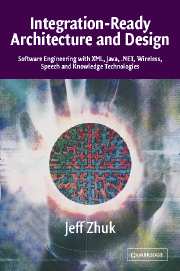 Integration-Ready Architecture and Design
Integration-Ready Architecture and Design Book contents
- Frontmatter
- Contents
- Preface
- Contributors
- Acknowledgments
- Introduction
- Notes for Educators: AMA Teaching Methods
- Chapter 1 Collaborative Engineering
- Chapter 2 Software Architecture and Integration Technologies
- Chapter 3 From a Specific Task to “Integration-Ready” Components
- Chapter 4 Integration with Voice
- Chapter 5 An Introduction to Knowledge Technologies
- Chapter 6 Write Once
- Chapter 7 The New Generation of Client–Server Software
- Chapter 8 Wireless Technologies
- Chapter 9 Programming Wireless Application Protocol Applications
- Chapter 10 A Single JavaCard Identity Key for All Doors and Services
- Chapter 11 The J2ME Family
- Chapter 12 Speech Technologies on the Way to a Natural User Interface
- Chapter 13 Integration with Knowledge
- Chapter 14 Distributed Life in the JXTA and Jini Communities
- Appendix 1 Java and C#: A Saga of Siblings
- Appendix 2 XML and Web Services
- Appendix 3 Source Examples
- Index
Chapter 13 - Integration with Knowledge
Published online by Cambridge University Press: 17 August 2009
- Frontmatter
- Contents
- Preface
- Contributors
- Acknowledgments
- Introduction
- Notes for Educators: AMA Teaching Methods
- Chapter 1 Collaborative Engineering
- Chapter 2 Software Architecture and Integration Technologies
- Chapter 3 From a Specific Task to “Integration-Ready” Components
- Chapter 4 Integration with Voice
- Chapter 5 An Introduction to Knowledge Technologies
- Chapter 6 Write Once
- Chapter 7 The New Generation of Client–Server Software
- Chapter 8 Wireless Technologies
- Chapter 9 Programming Wireless Application Protocol Applications
- Chapter 10 A Single JavaCard Identity Key for All Doors and Services
- Chapter 11 The J2ME Family
- Chapter 12 Speech Technologies on the Way to a Natural User Interface
- Chapter 13 Integration with Knowledge
- Chapter 14 Distributed Life in the JXTA and Jini Communities
- Appendix 1 Java and C#: A Saga of Siblings
- Appendix 2 XML and Web Services
- Appendix 3 Source Examples
- Index
Summary
Can people think? I doubt it. At least not in the way we do.
—Computer-to-computer chatThis chapter reveals the dependencies between a natural user interface (NUI) and knowledge technologies; discusses architecture, design, and code samples that integrate knowledge technologies into enterprise applications; and gives the keys to a new breed of software— “Softology,” a mix of software and ontological engineering.
We talked about NUIs in the previous chapter and agreed that they are not a trivial pursuit. We discussed at length a small part of an NUI—current speech technologies—and ended up with the conclusion that they can do a decent job when using machine-directed dialogs with multiple choices but are not quite ready to understand natural language spoken by a person.
We face similar difficulties with machine translation from foreign languages. I worked with multiple language translation programs that produced nonsense text filled with the right words.
WHY ARE COMPUTERS STUPID? WHAT IS MISSING?
Can tasks such as machine vision, speech recognition, and foreign language translation, which all seem very different, have a common solution?
The first common denominator is easy to find: all these tasks belong to the field of data interpretation. The next move is to find common steps for all three activities. What do people do when they are engaged in image or speech recognition, when they translate text from Hebrew to English? Why can't we build a program to perform similar steps?
The very first step is to recognize a business (social) domain area in which the data belong.
- Type
- Chapter
- Information
- Integration-Ready Architecture and DesignSoftware Engineering with XML, Java, .NET, Wireless, Speech, and Knowledge Technologies, pp. 387 - 445Publisher: Cambridge University PressPrint publication year: 2004
